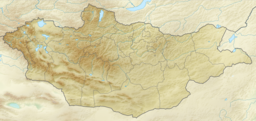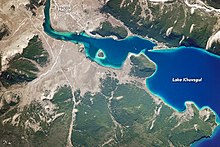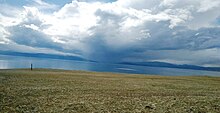geo.wikisort.org - Reservoir
Lake Khövsgöl is the largest freshwater lake in Mongolia by volume and second largest by area. It is located near the northern border of Mongolia, about 200 km (124 mi) west of the southern end of Lake Baikal. It is nicknamed the "Younger sister" of those two "sister lakes".
| Lake Khuvsgul | |
|---|---|
 | |
 Lake Khuvsgul | |
| Coordinates | 51°06′N 100°30′E |
| Type | Ancient lake, Rift lake |
| Primary outflows | Eg River |
| Basin countries | Mongolia |
| Max. length | 136 km (85 mi) |
| Max. width | 36.5 km (22.7 mi) |
| Surface area | 2,760 km2 (1,070 sq mi) |
| Average depth | 138 m (453 ft) |
| Max. depth | 267 m (876 ft) |
| Water volume | 480.7 km3 (115.3 cu mi) |
| Surface elevation | 1,645 m (5,397 ft) |
| Islands | Modon khui, Khadan khui, Modot tolgoi, Baga khui |
| Settlements | Khatgal, Khankh |
ᠨᠠᠭᠤᠷ
The lake's name is also spelled Hovsgol, Khövsgöl, or Huvsgul in English texts. It is called Хөвсгөл нуур Hövsgöl núr in Mongolian, and is also referred to as Хөвсгөл далай Hövsgöl dalai ("Ocean Khövsgöl") or Далай ээж Dalai éj ("Ocean Mother").
Geography
Lake Khuvsgul is located in the northwest of Mongolia near the Russian border, at the foot of the eastern Sayan Mountains. It is 1,645 metres (5,397 feet) above sea level, 136 kilometres (85 miles) long and 262 metres (860 feet) deep. It is the second-most voluminous freshwater lake in Asia, and holds almost 70% of Mongolia's fresh water and 0.4% of all the fresh water in the world.[1] The town of Hatgal lies at the southern end of the lake.
Lake Khuvsgul's watershed is relatively small, and it has only small tributaries. It is drained at the southern end by the Egiin Gol, which connects to the Selenge and ultimately flows into Lake Baikal. Between the two lakes, its waters travel more than 1,000 km (621 mi), and fall 1,169 metres (3,835 feet), although the line-of-sight distance is only about 200 km (124 mi). Its location in northern Mongolia forms one part of the southern border of the great Siberian taiga forest, where the dominant tree is the Siberian larch (Larix sibirica),


The lake is surrounded by several mountain ranges. The highest mountain is the Bürenkhaan / Mönkh Saridag (3,492 metres (11,457 feet)), whose peak, north of the lake, lies exactly on the Russian-Mongolian border. The lake freezes over completely in winter, and the ice cover is strong enough to carry heavy trucks; transport routes on its surface offer shortcuts to the normal roads. However, this practice is now forbidden, to prevent pollution of the lake from both oil leaks and trucks breaking through the ice. An estimated 30-40 vehicles have broken through the ice into the lake over the years.[citation needed]
There is a roughly elliptical island in the middle of the lake, named Wooden Boy Island, measuring 3 km east-west and 2 km north-south. It is located about 11 km from the lake's eastern shore, and 50 km north of the town of Hatgal.[2]
Ecological significance


Khuvsgul is one of seventeen ancient lakes in the world, being more than 2 million years old, and the most pristine (apart from Lake Vostok),[3][4] as well as being the most significant drinking water reserve of Mongolia. Its water is potable without any treatment. Hovsgol is an ultraoligotrophic lake with low levels of nutrients, primary productivity and high water clarity (Secchi depths > 18 m are common). Hovsgol's fish community is species-poor compared to that of Lake Baikal. Species of commercial and recreational interest include Eurasian perch (Perca fluviatilis), burbot (Lota lota), lenok (Brachymystax lenok), and the endangered endemic Hovsgol grayling (Thymallus nigrescens). Though endangered by poaching during its spawning runs, the Hovsgol grayling is still abundant throughout much of the lake.[5][6]
The Lake area is a National Park bigger than Yellowstone and strictly protected as a transition zone between Central Asian Steppe and the Siberian Taiga. Despite Hovsgol's protected status, illegal fishing is common and prohibitions against commercial fishing with gillnets are seldom enforced. The lake is traditionally considered sacred in a land suffering from arid conditions where most lakes are salty.
The Park is home to a variety of wildlife such as ibex, argali, elk, wolf, wolverine, musk deer, brown bear, Siberian moose, and sable.
The Hövsgöl (Khövsgöl) Long-term Ecological Research Site (LTERS) was established in 1997 and an extensive research program began soon thereafter. Now part of an international network of long-term study sites, the Hövsgöl LTERS provides a stage for nurturing Mongolia's scientific and environmental infrastructures, studying climate change, and developing sustainable responses to some of environmental challenges facing the lake and its watershed.
Recent studies has identified high levels of plastic pollution (esp. microplastics) in the lake, showing that even small rural populations can cause high plastics pollution levels, as high as elsewhere around the world.[7][8]
Etymology and transliterations
The name Khövsgöl is derived from Turkic words for "Khob Su Kol, means Lake with Great water"[9] Göl is the Turkic word for "lake" and today the Mongolian word for river. There are a number of different transcription variants, depending on whether the Cyrillic "х" is transliterated to "h" or "kh," or whether the "ө" is transliterated to "ö," "o," or "u." Transcriptions from the name in the classical Mongolian script, like Hubsugul, Khubsugul etc. may also be seen.
References
- "The Aquatic Invertebrates of the watershed of Lake Hovsgol in northern Mongolia". Institute for Mongolia Research Guide. Retrieved 2007-07-13.
- "Wooden Boy / Dalan Modon Khuis Island". Google Maps, accessed on 2019-05-24.
- worldlakes.org: lake Hovsgol, retrieved 2007-02-27
- Goulden, Clyde E. et al.: The Mongolian LTER: Hovsgol National Park Archived 2007-09-29 at the Wayback Machine, retrieved 2007-02-27
- DIVER Magazine, March 2009 Archived 2010-02-03 at the Wayback Machine
- Froese, Rainer; Pauly, Daniel (eds.) (2017). "Thymallus nigrescens" in FishBase. February 2017 version.
- "High-levels of microplastic pollution in a large, remote, mountain lake" Marine Pollution Bulletin, 15 August 2014
- "Why Pristine Lakes Are Filled With Toxins." BBC, 30 April 2018
- Shomfai, David Kara (2003) "Traditional musical life of Tuvans of Mongolia" in Melodii khoomei-III: 40, 80
External links
- New York Times article about kayaking on Khövsgöl
- Limnological Catalog of Mongolian Lakes
На других языках
[de] Chöwsgöl Nuur
Der Chöwsgöl Nuur oder Chöwsgöl Dalai (mongolisch Хөвсгөл Нуур, Chöwsgölsee bzw. Хөвсгөл Далай, Chöwsgöl-Meer) ist ein See in der Mongolei. Er ist der zweitgrößte See des Landes nach der Fläche (hinter dem Uws Nuur) und der größte nach dem Volumen. Er hat Bedeutung als Trinkwasser-Reservoir und als touristisches Reiseziel. Der Namenszug in klassischer mongolischer Schrift liest sich wie folgt:.- [en] Lake Khövsgöl
[es] Lago Ubsugul
El lago Ubsugul, Hövsgöl o Hövsgöl nuur (en mongol, Хѳвсгѳл нуур) es el segundo lago más grande de Mongolia y uno de los más importantes de Asia Central. Mide 136 km de largo y 262 m en su punto más profundo.[fr] Lac Khövsgöl
Le lac Khövsgöl (en mongol : ᠺᠥᠪᠰᠦᠭᠦᠯᠨᠠᠭᠤᠷ, VPMC : köbsügül naɣur, mongol cyrillique : Хөвсгөл нуур, Khövsgöl nuur ou Hövsgöl nuur) est le deuxième[1] plus grand (après le lac Uvs) et le plus profond lac de Mongolie. Il est situé au nord du pays, dans la province de Hövsgöl. Il mesure 136 km de long et 36 km de large. Ses eaux sont froides, gelées 4 mois par an (de janvier à avril).[it] Hôvsgôl Nuur
Il lago Hôvsgôl o Hôvsgôl nuur (mongolo Хөвсгөл нуур; la parola nuur in mongolo significa lago; Khövsgöl nella traslitterazione anglosassone, e ᠺᠥᠪᠰᠦᠭᠦᠯᠨᠠᠭᠤᠷnella scrittura mongola tradizionale) è un lago della Mongolia e si trova a nord del paese nell'omonima provincia del Hôvsgôl. Localmente è conosciuto anche come Hôvsgôl dalaj (Хөвсгөл далай, oceano Hôvsgôl) o Dalaj Èèž (Далай ээж, oceano madre).[ru] Хубсугул
Хубсугу́л (Хувсгел-Нуур, ранее Косогол; монг. Хөвсгөл нуур, монг. Хөвсгөл далай) — крупное пресноводное озеро на севере Монголии, рядом с границей России. Второе по площади и самое глубокое озеро в Монголии. По своему происхождению (озеро является частью Байкальского рифта), гидрологическому режиму и минеральному составу воды очень похоже на Байкал, иногда озеро называют «младший брат Байкала».Другой контент может иметь иную лицензию. Перед использованием материалов сайта WikiSort.org внимательно изучите правила лицензирования конкретных элементов наполнения сайта.
WikiSort.org - проект по пересортировке и дополнению контента Википедии
